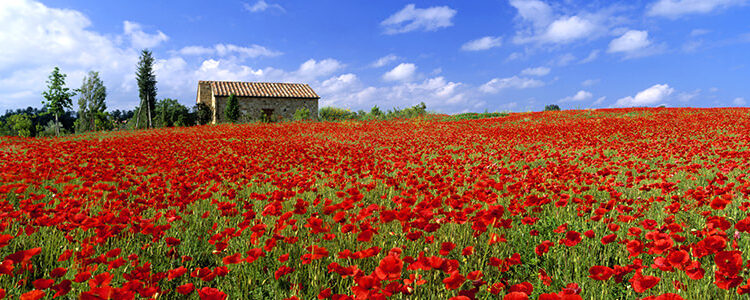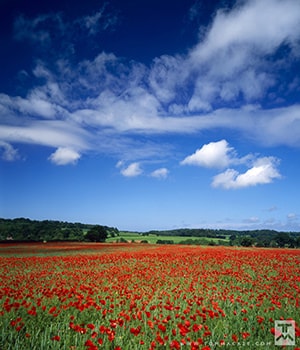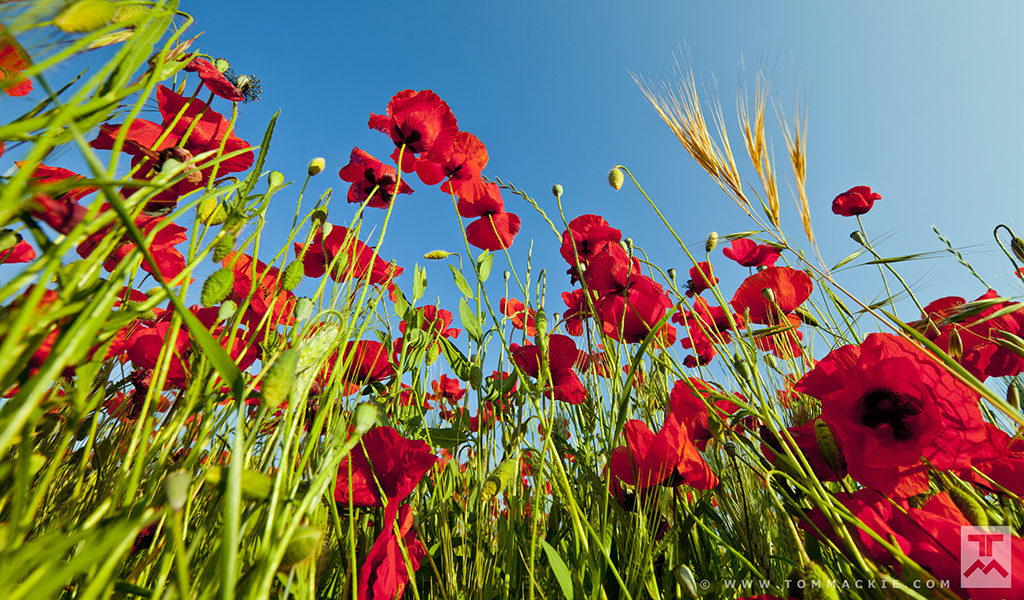
If you are planning on some early summer landscape photography, there is nothing better than to come across an unexpected poppy field full of scarlet red, set against a backdrop of the deepest blue sky. If you are lucky to live in the countryside or have easy access to it, finding a field of wild poppies can be quite easy to come across in the summer months.
Finding the best poppy field locations
It is tricky to know where a poppy field will be from one year to the next unless it is left totally untouched by farmers whereby the seeds will germinate again for the next year. So each year poppies will pop up in different and surprising locations so rather than waste time trying to re-discover the field you found last year do some research on the internet first so that you won’t be disappointed. Many websites offer information about finding the best poppy field locations and you if you ask around you may discover some not far from where you live. This will help ensure you maximise your summer landscape photography shooting time.
Poppies can be found in fields in many locations. In the UK particularly good spots can be found in North Norfolk, especially around Cromer in particular, parts of which are locally known as ‘Poppyland’. The Cotswolds in Gloucestershire and in Yorkshire near to York are other good locations and all merit visits as part of your summer landscape photography plans.
Summer landscape photography – create the best composition
To create the best landscape composition once you have found the perfect poppy field, there are a few basic features to go in search of:
Firstly, find a dense concentration of poppies with minimal weeds and no bare patches that will break up the expanse of colour.
Secondly, find a simple basic background, such as a group of trees or a hedge. Don’t let other distractions such as buildings or power lines get in the way. However, an interesting subject in the background for example a nice single specimen tree, a lighthouse or a church would be ideal.
Finally, the sky plays an important part of the overall composition as it can add atmosphere to the image, which you need to be mindful of with summer landscape photography. If it is a lovely summer’s sky full of white fluffy cumulous or cirrus clouds then you have the perfect opportunity to capture a stunning shot.
You can use three different techniques to obtain the same number of alternative looks when working in a field of poppies.
Use a wide-angle lens
The first technique is perhaps the most familiar one in landscape photography: use a wide-angle lens. A wide-angle lens has great depth-of-field capabilities and it gives you the sense of being able to walk into the scene. When you use a wide-angle lens, the natural inclination is to shoot at your own standing height or the full extension of your tripod and take in as much of the scene as possible. However, this can make all the elements in the landscape rather small and dilute the impact. By drawing in closer to something such as flowers gives the image more depth.
 If the sun is at a 90 degree angle to the camera you can try using a polarising filter to its maximum potential to make the clouds ‘pop’ from the blue sky and increase colour saturation. Usually the matrix metering mode of a DSLR camera is very accurate to correctly expose this type of scene but sometimes depending on the direction of the sun and the tone of the sky, underexposure can occur. If this occurs, you can try using a neutral density grad filter over the sky to balance or increase the exposure by using the exposure compensation feature on your camera.
If the sun is at a 90 degree angle to the camera you can try using a polarising filter to its maximum potential to make the clouds ‘pop’ from the blue sky and increase colour saturation. Usually the matrix metering mode of a DSLR camera is very accurate to correctly expose this type of scene but sometimes depending on the direction of the sun and the tone of the sky, underexposure can occur. If this occurs, you can try using a neutral density grad filter over the sky to balance or increase the exposure by using the exposure compensation feature on your camera.
Sometimes when flowers in the foreground are moving in the breeze and you use a small aperture to achieve more depth-of-field and a low ISO, this can result in blurred flowers. Using a tilt/shift lens will help solve this problem. By tilting the lens and changing the orientation of the plane of focus, will allow the use of a wider aperture, thus a faster shutter speed to capture the moving flowers.
Use a telephoto lens
The second technique you can use is to isolate or compress the subject using a telephoto lens. By isolating a single poppy or two using a telephoto lens, such as a 70-200mm with the aperture wide open, will allow the use of a shallow depth-of-field. This selective focus technique draws attention to the subject and you can also use selective colour if you have a single red poppy or just a few amongst a field of white or yellow flowers for example.
To achieve this technique you will need to place your telephoto lens fairly close to the poppy so that the background and any foreground falls out of focus. Then by using a wide aperture of around f/4, there will be little depth-of-field and a creamy subtle background. The viewer’s attention will be easily drawn to the sharpest point in the frame.
A telephoto lens is also useful to compress the scene if for instance the field of poppies is not particularly dense or if you want to compress features in the scene such as trees. If you stand and look across a field of poppies the flowers in the distance will obviously look denser further away from you and you will be able to see more green vegetation between the poppies that are closest to you.
Shoot from an unusual angle
 A good final technique is to use an unusual angle to get a completely unique perspective on the poppies.
A good final technique is to use an unusual angle to get a completely unique perspective on the poppies.
A really fun idea is to get a ‘bug’s eye view’ by shooting up to the sky using a really low angle. This is a great way to create an image out of the typical views of poppies as you never really know what you will come up with. Fit the camera with a wide-angle lens such as a 16-35mm lens set at 16mm and place the camera on the ground facing upwards so there is no need for a tripod. With this technique you are literally shooting blind, as you cannot look through the viewfinder to see what you are doing unless your camera has a display that pivots out!
It’s best if you shoot away from the sun keeping it at a 90 degree angle to the camera to get the most effective polarisation but beware of any flare from the sun. It can be tricky to compose and calculate the exposure and will be something you have to work at to get it right. Once you have done the initial composition you can adjust the camera and move the plants until you obtain a composition you are happy with.
For something a bit more dramatic you can shoot at this angle but point the camera towards the sun, this time use your pop-up or hotshoe mounted Speedlite to light the flowers. You will need to experiment with flash exposure compensation, or add a little extra flash power to get the balance right, and perhaps a small amount of minus exposure compensation in-camera. If you give it a try you will see how striking the images can be.
So when you are out in the countryside searching for those glorious flashes of red, remember to try these three simple techniques to create your picture perfect poppies and improve your summer landscape photography.

